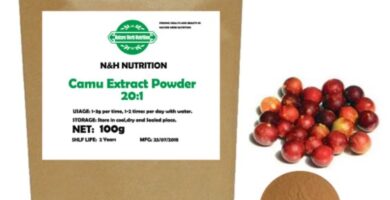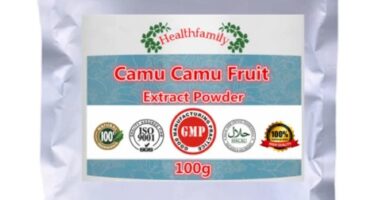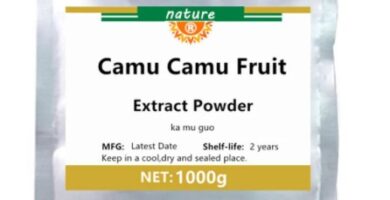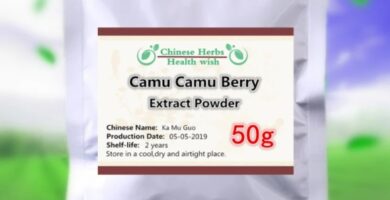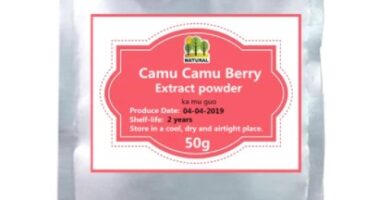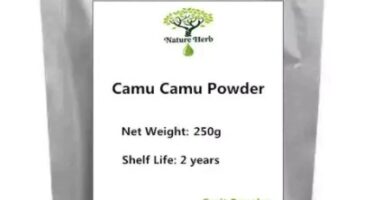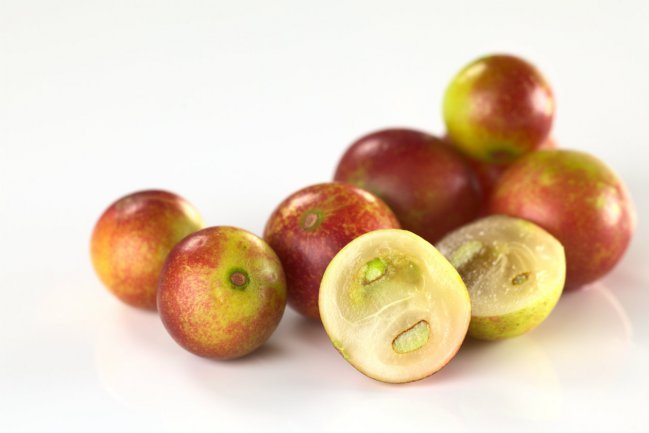
The camu-camu , cacari, arazá de agua, guayabillo, guayabito, azedinha, etc., is the fruit of a shrub from 3 to 8 m high, of the Myrtaceae family, native to the Amazon basin , which contributes about 2,994 mg/100 g, although it can reach up to 4,000 mg of vitamin C per 100 g.
What is the fruit that has the most vitamin C in the whole world? The camu-camu ? I’ve never heard of that fruit… And the richest in vitamin C, isn’t it the orange? or lemon?
The lemon, popularly considered one of the richest fruits in vitamin C, is far from it. It provides about 50 mg per 100 g of edible pulp, far surpassed by other fruits such as guava (228 mg), blackcurrant (200 mg), red pepper (190 mg), chili pepper (144 mg). ), parsley (120 mg) and other fruits and vegetables.
But those are the minor leagues of vitamin C richness.

Dr. Rafael Cartay is a Venezuelan economist, historian, and writer best known for his extensive work in gastronomy, and has received the National Nutrition Award, Gourmand World Cookbook Award, Best Kitchen Dictionary, and The Great Gold Fork. He began his research on the Amazon in 2014 and lived in Iquitos during 2015, where he wrote The Peruvian Amazon Table (2016), the Dictionary of Food and Cuisine of the Amazon Basin (2020), and the online portal delAmazonas.com, of which he is co-founder and main writer. Books by Rafael Cartay can be found on Amazon.com
Benefits of camu-camu scientifically proven
Some research works indicate that the consumption of camu camu contributes to increasing serotonin levels, recognizing its effects as an antidepressant.
Most studies, acknowledging the rich vitamin C content of camu camu, attribute a high contribution to:
- Strengthen the body’s immune system ,
- Protect the liver (thanks to the component 1-methyl malate,
- Improve low mood (due to its relationship with serotonin),
- Take care of the mucous membranes and gums avoiding infections and inflammations ,
- Fight premature aging and cell degeneration (due to its high antioxidant power),
- Improve eye health (due to its content of vitamin C, carotenoids, lutein and zeaxanthin),
- Hypolipidemic effects, by reducing the concentrations of triglycerides and cholesterol.
Where to buy Camu-camu?
This superfood can be found in powder form at health food stores, and online department stores. The fresh fruit is obtained in the Amazonian markets of Iquitos in Peru, and in Manaus and Belem do Pará in Brazil. Here are some links to online stores that offer this product in powder form.
Which fruit has the most vitamin C? The camu-camu or the kakadú
Specialists point out that the two fruits with the highest concentration of vitamin C in the world are kakadú ( Terminalia ferdinandiana) and camu camu ( Myrciaria dubia ) .
The kakadú, murunga or mador, is the fruit of a tropical tree native to Australia, up to 20 m high, of the Combretaceae family, which provides about 3,150 mg/100 g.
Whatever the definitive figures for vitamin C content, there is no doubt that these two fruits are, so far, the richest in vitamin C in the world.
Botanical description of the camu-camu plant ( Myrciaria dubia )
The camu camu ( Myrciaria dubia HBK Mc Vaugh ) is a shrub, 3 to 18 m tall, native to the Amazon basin, with a straight, thin and smooth trunk, 10 to 15 cm in diameter, highly branched, with branches that They come out of the ground.

Its bark is light brown or greyish.
Its leaves are opposite, dark green and shiny on the upper side, and light green and opaque on the underside.
The fruit is a globose or spherical berry, 1 to 5 cm in diameter and variable weight between 2 to 20 g.
When ripe it turns from green to reddish-brown to violet-black.
Its pulp is fleshy, edible, with an acid taste, soft, with 1 to 4 elliptical or kidney-shaped seeds inside.
The fruit (peel and fruit) is a rich source of vitamin C, phenolic compounds, anthocyanins, flavonoids and carotenoids.
It is also a good source of potassium, iron, calcium, phosphorus, and various kinds of amino acids, such as serine, valine, and leucine.
The plant reproduces sexually by seed, or asexually by grafting.
Due to its richness in antioxidants and other bioactive components, it has been considered a superfood, a functional food or a nutraceutical.
Food uses of camu camu
Despite its richness in vitamin C and antioxidants, the efficacy of its components has not been sufficiently experimentally evaluated in humans.
It is known that the efficacy of some components decreases and others increases as the camu-camu fruit matures.
For example, the content of vitamin C, or ascorbic acid, decreases with ripening, but the anthocyanin, flavonol and antioxidant capacity increase.
The pulp of the fruit is used to prepare juices, sorbets, ice cream, yogurt, cocktails, jams, vinegar.
With the pulp, combined with seaweed (agar agar) and yacon, a highly nutritious jelly has been produced in Peru under the name jellykids .
On the other hand, camu camu, which grows in flooded areas, is a food for the ichthyological fauna, that is, for fish .
Camu camu became important in Peru from the 1990s, although there are many difficulties in marketing it due to its irregular availability.
Its demand grew very quickly and the supply of the fruit was limited due to its origin from existing wild trees in the Amazon.
What led to an over-exploitation of the species, which put the conservation of the species at risk.
Medicinal uses of camu-camu
The high presence of vitamin C and other components has enhanced its pharmacological properties, as an antianemic, antiviral, analgesic, anti-inflammatory, healing, antispasmodic and antioxidant product.
In 2007 researchers from the Research Institute of the Peruvian Amazon (IIAP) carried out an ethnopharmacological study in the northeast of the Peruvian Amazon, through the application of 108 surveys, both in rural and urban areas.
They found that six parts of the plant are used in popular medicine: ripe fruit (64%), stem (19%), green fruit (6%), leaves (6%), seeds and root (5%), to treat arthritis (33%), cold (17%), diabetes (11%), cholesterol (7%), bronchitis (4%), vitamin C deficiencies (4%), inflammations (2%) and other diseases (22%).
Application mode
Its application is done in different ways: fresh extract or juice, cooking of the bark of the stem in extracts, infusions, lyophilized powder, capsules, juice and cream.
The bark of the camu camu is traditionally used for the elaboration of the Amazonian liquor called seven roots, macerating its components in liquor for seven days to treat rheumatism.
The decoction of the bark and root is used to treat rheumatism and diarrhoea.
The bark scraped and heated with water is used to relieve muscle pain. With the leaves crushed and submerged in water, fever, headache and migraines are combated.
Various parts of the plant are used for the treatment of asthma, arteriosclerosis, cataracts, gingivitis, glaucoma, hepatitis, osteoporosis.
However, these applications of popular medicine are not experimentally supported.
Limitations and problems of camu camu
The ripe fruit of the camu camu is very delicate and perishable, as a result of its high water content, up to 90%, and vitamin C, which is very unstable.
The fruit under normal conditions does not last more than 10 days. Since it comes from areas of the Amazon basin, which are generally remote and difficult to access, it is difficult to market, since there are delays in its transfer to urban markets.
In general, the fruit is harvested green to facilitate its commercialization, which deteriorates its appearance, reduces the presence of anthocyanin in the peel and its vitamin C content.
The specialists begin to harvest the pintón fruit, transporting it in containers with a maximum capacity of 5 kg. To preserve the pulp, which represents 55% of the weight of the fruit, it is recommended to freeze it immediately after pulping at minus 10 °C.
The high perishability of the fruit also influences its reproduction. The seed lasts 3 to 4 days outside the fruit.
Inside it up to 10 days. If the seed is refrigerated, it lasts 1 month, and up to 6 months at room temperature, provided that the seeds are soaked and the water is renewed every day. With a planting density of 3 x 3 m, the production is 10 t per hectare/year.
Other problems of the plant and the fruit of camu camu is the great variability of the species.
Another is the susceptibility of the fruit to damage and bruising in the process of harvesting, transport and storage. The avocado is also prone to being attacked by pests.
Finally, the transformation of the fruit by freeze-drying is a relatively expensive process.
All these problems are aggravated because there is not enough research related to the genetic improvement of the plant, its agronomic management and the control of pests and diseases.
An Amazonian species similar to camu camu
There is a species similar to camu camu, but it is arboreal. It is Myrciaria floribunda, a tree that reaches up to 40 m in height, whose fruit is a globose or spherical berry, with fleshy, edible pulp, colored between purple and dark brown, with an acid taste and with a lower vitamin content. C than the species Myrciaria dubia.
The importance of acidity
Sour taste is one of the basic flavors detected by the taste buds on the tongue.
It is detected by sensors, identified as TAS 21R, which capture, through ion channels, the presence of different organic acids (acetic, citric, tartaric, oxalic, malic) in the water where it forms hydronic ions.
Acid produces hydrogen or oxonium ions, which produces a feeling of rejection to safeguard us, because some toxic substances have an acid taste.
This rejection is an expression of the organism that manifests a physiological defense against poisoning. But not all types of sour taste are unpleasant and harmful.
How is the acidity of a substance measured ?
The pH value is an indicator of the acid content of a substance. pH is a scale from 0 to 14, and measures the concentration of positively charged hydrogen ions (H+).
On this scale, the value 7, the average value, is assigned to a substance that is neither acid nor alkaline.
Substances with values below 7 are considered acidic.
Those that are above 7 are considered alkaline.
That pH scale is not simple, but logarithmic: small changes in the pH measurement represent large changes in the concentration of ions (H+) and, consequently, in acidity.
The pH of a substance is measured using pH strips, or photometric indicators, or potentiometry techniques, which is the most accurate and most widely used method today.
The process is not simple, but the measurement is made much easier by using an instrument known as the ATAGO PAL-easy ACID, which measures the level of acids through electrical conductivity, and without using reagents.
It does not measure the acidity of each class of acid separately, but using a total acid conversion that is expressed as a function of the predominant acid in the analyzed sample (titratable acidity).
And express the result as a percentage. For example, in oils it is expressed in % of oleic acid, in fruit juice in % of citric acid, in milk in % of lactic acid.
The importance of the acidity of a food
Microorganisms do not survive or grow in acid media, but rather in environments with a pH between 4.6 and 9.
The problem is that most foods are naturally acidic, but their acidity is less than 7.
That is, not less than 4.6, which is the value that is not of interest because it represents food security.
At a value of 4.6, a very pernicious bacterium does not grow, Clostridium botulinum, responsible for botulism, a serious poisoning caused by the ingestion of food packaged in poor conditions, and which can be fatal. In such a way that the pH value of 4.6 is used to classify foods according to the notion of food safety. Below that threshold there is greater physiological protection.
But it must be taken into account that the pH value of a food is not constant, but rather varies according to the variety of the plant, the degree of maturity of a fruit and the variations in temperature to which it is subjected. .
The acidity of a fruit is important, in short, because it acts as a protective barrier against pathogenic microorganisms that spoil it and can cause illness in the consumer.
People’s beliefs about the most acidic fruits
The most acidic fruits, people believe, are citrus fruits, particularly lemon and lime. Citric acid is a natural compound present in many fruits. But over time it was synthesized in Italy, in 1860, and used more and more in industry. Experimental tests have shown, however, that natural citric acid is more efficient than synthetic citric acid in fulfilling its functions as a preservative and antioxidant.
Among the most acidic fruits we find lemon (pH 2.2 to 2.4), strawberry (3.0 to 3.5), grape (3.4 to 4.5), apple (3.4 to 3, 9). Vegetables and vegetables include tomatoes (4.2 to 4.9), peppers (4.6 to 4.9) and carrots (4.9 to 5.2).
Citric Acid Uses
Citric acid is used in the food industry as a food additive that has many applications: preservative, flavoring and antioxidant. And also in the pharmaceutical industry, to obtain effervescence and flavor and as a blood anticoagulant. Let us remember that vitamin C cannot be produced by the human body, although animal and plant organisms do, and it must be provided by external sources. Its production is important, and the largest producers in the world are the European Union, the United States, China, Brazil and Colombia.
Bibliography used
- Akter MS, Oh S, Eun JB, Ahmed M (2011). Nutritional composition and health promoting phytochemicals of camu-camu ( Myrciaria dubia ). Fruit: a review, Food Research International, Vol. 44 (7), 1728-1732. PDF
- Belly R. (1994). Useful plants of the Peruvian Amazon: characteristics, uses and possibilities. Lima: Ed. CONCYTEC. Source
- Berrú Nolasco EY et al. (2019). Production and marketing of nutritious gelatin based on seaweed, camu-camu and yacón. Saint Ignatius of Loyola University. Industrial Engineering career. Lima Peru.
- Brack Egg A. (2012). Dictionary of fruits and fruits of Peru. Lima: San Martin de Porres University. Source
- BJ Causeway (1985). Some fruit trees from the Amazon rainforest of interest to the industry. Lima: IICA. Miscellaneous Publications 602. PDF
- camu camu (2018).Agroaldia.minagri.gob.pe/library/download/pdf/thematics/f-taxonomia_plantas/f-01-cultivo/2018/ficha_tema_camu-camu-pdf. PDF
- Cartay R. (2016). The Peruvian Amazon table. Ingredients, corpus and symbols. Lima: San Martin de Porres University. Source
- Cavalcante PB (1991). Edible fruits of the Amazon. Belem: CEJUP.
- Chang Channels A. (2013). The camu camu: chemical, pharmacological and technological aspects. ICA, Peru. National University of the Peruvian Amazon (UNAP)/ Research Institute of the Peruvian Amazon (IIAP). PDF
- Chirinos R., Galarza J., Betalleluz I., Pedreschi R., Campos D. (2010). Antioxidant compounds and antioxidant capacity of Peruvian camu camu ( Myrciaria dubia(HBK) Mc Vaugh) fruit at different maturity stages. Foodd Chemistry, Vol 120 (4), 1019-1024. Source
- Duke JL; Vasquez R. (1994). Amazonian Ethnobotanical Dictionary. Ann Arbor: CRC Press. Source
- Star D. (1995). Amazonian medicinal plants: realities and perspectives. Source
- P.S. Flowers (1997). Cultivation of native Amazonian fruit trees. Manual for the hiker. Lima: TCA. Source
- Guija H, Troncoso L, Guija E. (2005). Pro-oxidant properties of camu camu (Myrciaria dubia). Annals of the Faculty of Medicine. 66 (4), 261-268. National University of San Andres. Lime. Source
- Magnet Correa S. et al. (2011). Vitamin C content in camu camu fruits ( Myrciaria dubia HBK McVaugh), in four stages of maturation, from the INIAP Germplasm Collection, Loreto, Peru. Scientia agropecuaria, 2, 123-130. National university of Trujillo. PDF
- Inoue T, Komoda H, Uchida T, Node K (2008). Tropical fruit camu-camu ( Myrciaria dubia) has anti-oxidative and anti-inflammatory properties. Journal of Cardiology, 52, 127-132. Source
- Peters CM; Vasquez A. (1985). Ecological studies of camu camu ( Myrciaria dubia ). Fruit production in natural populations. In: Peters CM Ecological Studies of Native Fruit Trees of the Peruvian Amazon. IIAP-IEB/NYBG agreement. Annual report. Iquitos, 53-65. Source
- Pinedo PM, Arms M. (2007). The camu camu and its popular uses as a medicinal plant. LEISA. Agroecological Magazine. 23 (3), 22-24. Source
- Rengifo E. (2010). Camu camu monograph. Myrciaria dubia HBK. Lima: Promperu. PDF
- Rubio Valley A. (2010). Marketing and consumption of camu-camu, case: popular feeders of San Juan de Lurigancho. Source
- Ruiz MJ (1993). Food from the Amazon forest. An alternative for the protection of tropical forests. Montevideo: UNESCO/ ORCYT, 96-98. Source
- Schwertz MC et al (2012). Hypolipidamic effect of camu-camu in rats. Rev. Nourish Campinas, 25 (1), 35-44. Source
- Yuyama K, Aguiar J, Yuyama L (2002). Camu camu: a fantastic fruit as a source of vitamin C. Acta Amazónica, 32 (1), 169-174. Source
- Zanalta CF, Merchant AZ (2007). Carotenoid composition from the brazilian fruit camu-camu (Myrciaria dubia). Food Chemistry, 101 (4), 1526-1532.
- Zapata-Cuéllar AG et al. (2019). Business plan for a company dedicated to the export of camu-camu to China, Degree thesis. Scientific University of the South. Lima Peru. Source
Related Posts
January 25, 2020
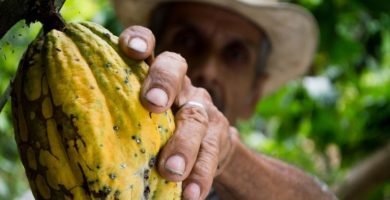
Cocoa (Theobroma cacao)
January 22, 2020

3 scientific studies on ayahuasca
January 10, 2020
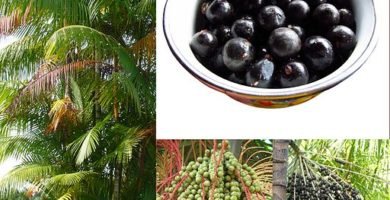
Acai, asai, asaí or açaí: a fruit that cures EVERYTHING!
December 9, 2019

Dragon Fruit Benefits – The healthy power of Pitayas
November 25, 2019

Brazil Nut (Bertholletia excelsa)
October 28, 2019

7 medicinal fruits of the Amazon Rainforest
October 20, 2019
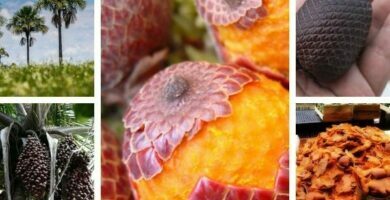
Mauritia Flexuosa: “The tree of life” (Buriti or Moriche palm)
October 6, 2019

Amazon Rainforest foragers
October 5, 2019

Amazonian fruits – Jungle Fruits and Super Food
This post is also available in:
![]() Español (Spanish)
Español (Spanish)

